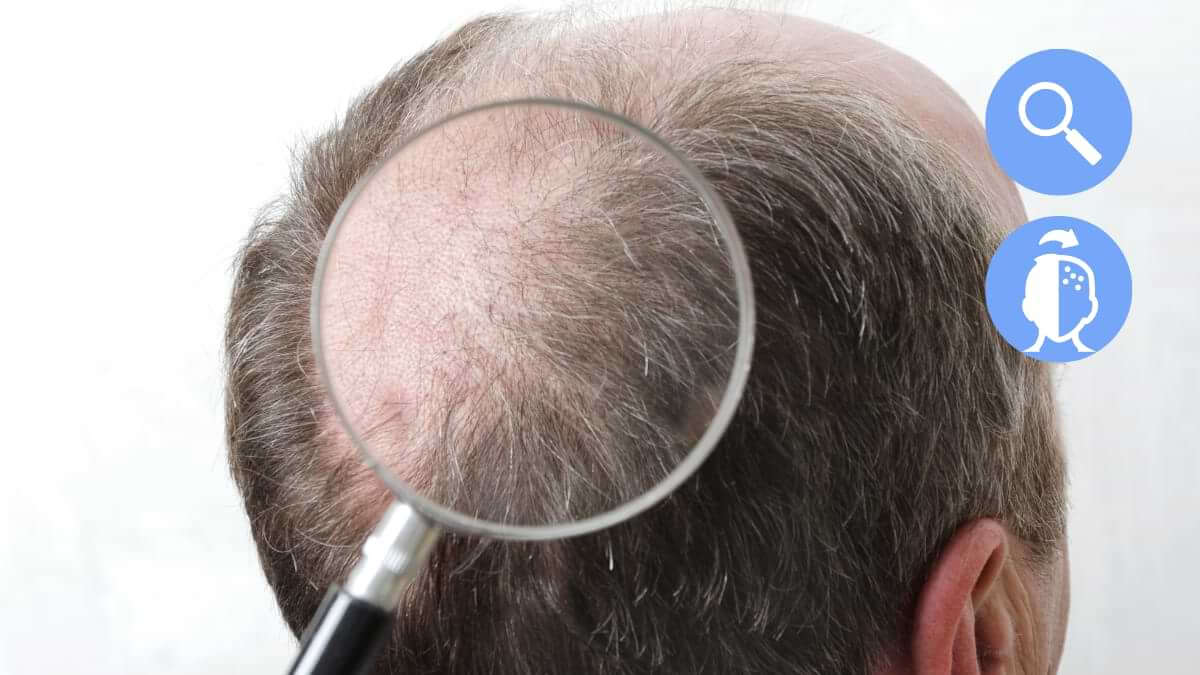For each MPB patient, knowing if you are even an eligible candidate in the first place is difficult enough.
In such a delicate field, there are some questions that you can answer on your own and some that you can’t. 🥼
Especially for patients considering a hair transplant, the most common questions I get every day are:
“How many hair grafts do I need in my donor area?”
or
“How many hair grafts do I need to cover my recipient area?”
Luckily, these are among the questions that you can answer. 💡
And your best tool for doing so lies right at the top of your head: It is your donor area.
To clarify your concerns, I will delve into the donor area and what it can reveal.
👉 That way, we can determine the success of your surgery even before it begins:
In today’s article, I will explain how you can find out your donor area capacity, take care of it, and calculate it correctly.
Table of Contents
Let’s start with the obvious question in your mind:
What is my donor area capacity?
To understand what it is, we should first start by understanding your donor area.
In each hair transplant patient’s scalp, we divide the hair into two essential parts:
💠 One is the part that gets a transplant, which we call the recipient zone.
💠 The other is the part that gives the hair grafts for transplantation, which we call the donor area.
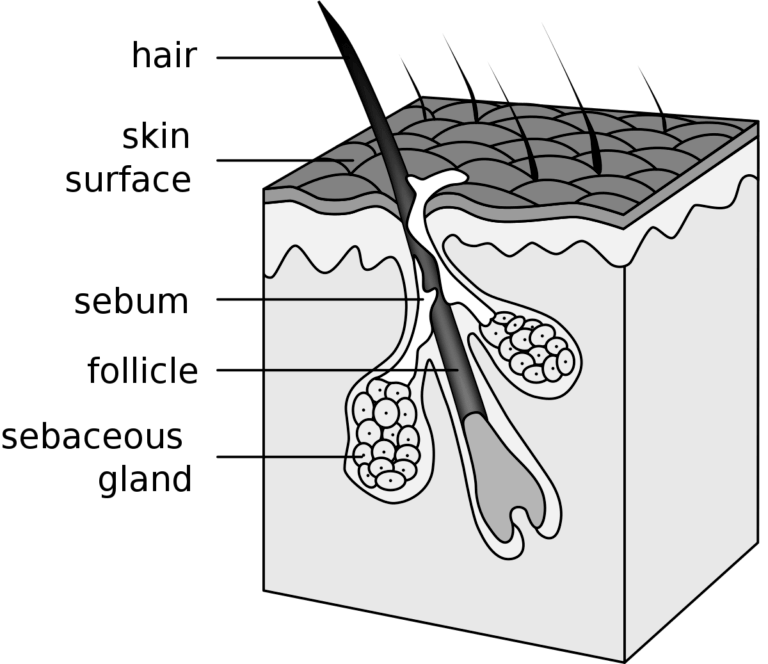
It is a common misconception that some patients believe we directly transplant hair. But instead, we transplant hair follicles.
And over time, the hair you see on your head daily grows from these follicles. The hair itself may fall and regrow over time despite the damage it takes.But too much pressure on hair follicles can permanently erase them, which we define as balding.
In other words, once you lose your hair grafts, you won’t be able to grow your hair back. When that happens, we require the help of hair transplant surgeries.
However, that is where the definition and value of donor area capacity comes in.
👉 The more advanced a patient’s balding gets, the more hair follicles they will require to cover the entire area, which we call the donor area capacity.
So, potentially, extremely advanced balding can be near-impossible to cover even with a transplant, as there may not be enough follicles remaining.
I know that this is the rare scenario that concerns you.
But do not worry because we have three failsafe options for this scenario:
➡️ The first is that for each patient wondering if it is too late to save their hair’s future, there are some signs you can look for to make sure.
➡️ Secondly, your daily hair care can help you avoid this future.
➡️ And last of all, in dermatology, we use an extremely delicate process and modern tools to maximize your transplant’s success in covering your baldness.
Let’s start with the first one:
How can you approximately assess the donor area?
Now that you know what a donor area capacity is, it’s time to know what YOUR donor area capacity is.
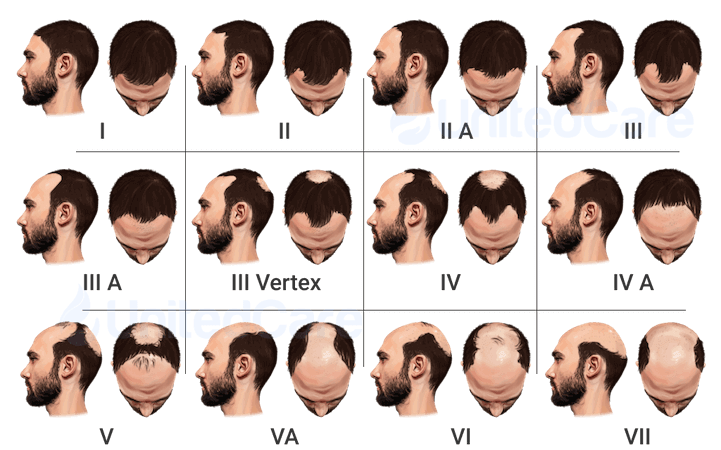
☝️ The image on the top is the Hamilton-Norwood Scale for Classification of Male Pattern Baldness.
It is amongst the most popular scales we use for determining how much a patient’s baldness has advanced.
As a patient has no way of knowing exactly how many hair grafts there are in his scalp (in his daily life, without applying for medical tools) and how much he will need, using this scale can help to get an idea of his hair’s health.
🔔 By looking into the signs I mention, you can use The Hamilton-Norwood Scale to check where your hair approximately fits. That way, your donor area can reveal a glimpse of your transplant potential.
There are three factors you can look at to calculate your donor area’s capacity:
1️⃣ Your hair’s density: A donor area filled with thick hair is your primary guarantee of saving the rest of your scalp.
If you can feel large groups of dense hair in your donor area, you have strong hair follicles that will support your surgery well.
2️⃣ The level of your hair’s miniaturization: Miniaturization is the process of your hair strands getting thinner. It is the first step in hair loss.
As hair follicles lose their condition over time, they first experience miniaturization and shedding.
So, if your donor area is full of hair with minimal thinning and mostly thick enough to cover your head, it means your donor area is healthier.
3️⃣ The stability of your hairline: When assessing yourself, there is no way to know the exact number of hair follicles you have in your donor area.
However, you can at least learn if you have a steady and high number of them. You can do this by checking the beginning of your donor area’s hairline.
A stable hairline suggests a high supply of strong donor hair exists in your donor area.
👉 Ultimately, however, these are still predictions as you have no way of knowing your potential, as without medical tools, getting an exact number is impossible.
However, by using a free and personalized graft calculator, you can get the exact numbers you need:
Find out how many grafts you need now.
UnitedCare’s free and personalized graft calculator is here for you.
Knowing how healthy your donor area is amongst the first steps to achieving a better-looking future for your hair.
Preserving that health in your daily life to achieve long-term results is just as important:
How should you take care of it in your everyday life?

I have already explained how the concept of your donor area capacity can determine the number of grafts that will be transplanted.
However, the critical part that I need to highlight is that donor area capacity consists of personal factors that vary from one person to another, such as:
🔶 Hair density,
🔶 Donor area size,
🔶 and hair type.
But your options for preserving what you have do NOT.
There are three habits you can include in your daily life to preserve your donor area’s health or even improve it:
1️⃣ Maintaining a healthier diet.
The most effective technique we advise our patients is the Mediterranean diet.
According to a study, its ingredients of primarily high protein, raw vegetables, and fresh herbs highly contribute to its effectiveness in reducing the risk of hair loss. With this diet, you should try to consume raw vegetables and fresh herbs at least three times a week to see the results of this diet.
2️⃣ Maintaining high blood circulation in your scalp.
Movement and stimulation with exercise increase the amount of blood circulation in your scalp, which turns into more oxygen and nutrition flow going to your hair follicles.
Alternatively, you can also apply scalp massages to stimulate the blood circulation in your scalp. A study showed that hair loss stabilization and increased regrowth were reported in 69% of 340 patients who have done scalp massages of 10 to 20 minutes twice a day for six months.
3️⃣ Maintaining a stress-free life.
According to a study, researchers have found a direct link between hair loss and stress levels, as high amounts of continuous pressure from non-released stress increase hair loss.
By applying the other options, such as exercise, you can significantly reduce mental stress by allowing your body to release tension.
💡 Ultimately, the critical thing to remember is that your goal is to preserve your donor area’s health before surgery.
So, these options are NOT meant to be alternatives to hair transplants. They are merely for protecting your donor area until it is time to use it for a transplant.
That is why the best thing to do to benefit the best from your donor area is to apply for professional consultation as soon as possible.
Reveal your donor area’s full potential now.
Talk to a Dermatosurgeon for free to learn more about your donor area.
Because without consultation, we can only control our expectations:
What to expect from your donor area?
🔔 First of all, the most important thing is that you must have realistic expectations.
Patients’ most common mistake during this phase is either overestimating their donor area’s potential or not aiming for achievable outcomes.
Avoiding disappointment is as crucial as avoiding failure.
That is why you should use hair transplant eligibility conditions to know what to expect from your donor area.
Here are two essential things to expect for a donor area with the highest capacity:
1- Having a large and healthy donor area.
As hair transplants require follicles, their numbers from the healthy areas in your head that are NOT affected by male pattern baldness will heavily influence the outcome.
QUOTE: “The average number of grafts harvested in a hair transplant surgery is approximately 2000.
That is why when you look up costs of hair transplant surgeries, clinics usually provide 2000 Graft Cost along with the price per graft cost.”
So, the first thing to expect from your donor area should be high numbers and a large group unaffected by androgenetic alopecia.
Ultimately, your donor area should equal the balding area for best results.
2- Being within the ideal age gap.
👉 There is no scientifically definitive age threshold that you must pass to be eligible for hair transplant surgery.
However, we can determine an age gap based on the universal success rates of patients and the hair regrowth process of your body that changes throughout your life.
So, ideally, patients between the ages of 25-65 are best suited for this operation.
Age strongly affects whether your hair is thick enough to survive the transplant, and being within the gap is ideal for a certain level of stability in your hair loss pattern.
💡Overall, aside from these factors, whether you are comfortable with getting surgery is a factor that we highly value as well.
So, the safest option is to talk to your doctor before deciding.
That being said, you can alternatively always ask for help from our Care Assistant in reading your donor area’s health and understanding what to expect:
Learn more about your donor area now with the help of our Care Assistant.
Reading your donor area has never been this easy or healthy.
One final to note is that patients tend to risk their hair’s health by underestimating their balding condition:
QUOTE: “⚠️ One internal factor that puts hair loss patients at risk in the long-term is the cognitive bias known as Over-Optimism.
In simple terms, patients often overestimate the number of grafts they have and underestimate the amount they need. This ultimately leads to them procrastinating the help they need immediately, and thus failure.
That is why the need for professional evaluation is almost urgent. “
👍 Ideally, your best bet is always benefiting from both the daily practices and medical help.
But of course, daily care alone may not be sufficient or optimal for all patients.
In that case, we suggest you apply for professional help right away:
How are professional donor area calculations made?
In the field of dermatology, every clinic uses the same fundamental process for making donor area calculations before the surgery.
👉 First, we assess the donor area capacity. Then, we determine how much the balding area will need from that capacity.
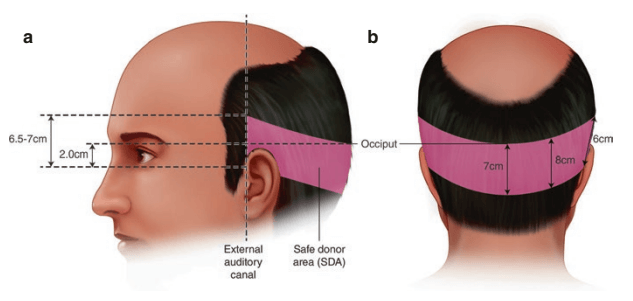
To assess your donor area capacity, we check two things:
1️⃣ Number of your grafts.
Using professional medical tools such as the popular KE-BOT for digital planning, we first observe your scalp to see how many hair grafts you have left.
That way, we get to see your total donor capacity.
2️⃣ Thickness and strength of your grafts.
The same advanced, modern options also allow us to scan your hair grafts on a microscopic level.
By observing your scalp on such a detailed level, we get the chance to have the exact data of:
- Each hair graft’s thickness, diameter, and caliber,
- Along with the hair density in the donor area.
So, your precious and limited donor hairs are used wisely to cover your bald or thinning zones.
⚠️ However, some conditions change from one patient to another and must be considered.
Here are the two external factors outside of our control:
- Structure of your hair: Wavy, curly, straight.
- Color/contrast compared to the scalp’s skin.
These are conditions that are unique for each patient and may have some effect on the necessary grafts for the transplant.
As for genetic factors, the most a clinic can do is properly examine and 360° scan the scalp for accurate pre-surgery preparations. 💉
That way, the clinic can know better how to handle your grafts the best and how much of it you will need for transplantation.
Speaking of which, two things are used to know how many grafts you will need for a transplant:
1️⃣ Caliber
Using the same tools again, your clinic will analyze your balding areas to check the exact width, diameter, and caliber of your hair follicles and stands.
These numbers are vital as, depending on the caliber size, your doctor can measure how much hair must be transplanted to cover the entire area.
2️⃣ Graft necessary per square cm2
Covering your entire balding area also requires some amount of hair in addition to the caliber.
💡 In fact, dermatology has an equation for that called the coverage value.
In simple terms, the coverage value is the necessary number for sufficiently covering up your balding areas.
Its mathematical value is The number of hair you need multiplied by the thickness of your hair. 🥼
After we run this equation and reach the result successfully, we can finally determine the grafts necessary per square cm2 to cover the balding.
And in the end, these will create the price measurements for your scalp.
However, remember that these methods will ultimately stay ineffective if you delay applying for a clinic further.
That is why the next best time to do a donor area calculation is right now:
Get your free donor area calculation now.
At UnitedCare, using your KE-BOT Mobile to preserve your donor bank is just a single step of every precaution we take.
We first begin your pre-surgery treatment with a thorough examination.
After I examine the hair and scalp condition, I will ask you some questions to get more information about your family genetics, medical history, habits, and lifestyle for personalized treatment.
With the dermatoscope, a tricoscopic examination is done to get telogen and miniaturization rates. This check gives a clear idea about donor hair quality and amount.
We don’t simply plan to cover bald spots on the scalp, instead we:
- Determine the severity of Androgenetic Alopecia (MPB),
- Figure out how AGA would advance,
- Identify high-risk balding zones in the next 2-3 years,
- Measure cosmetic appearance with respect to head shape.
Only an experienced dermatologist surgeon can do this kind of long-term planning.
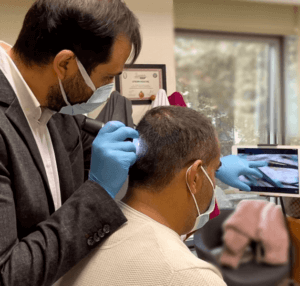
Then, I make the required calculations for optimum coverage. A precise number of grafts planned to be transplanted is determined at this point. We don’t overharvest or deplete your donor area but provide you with the best coverage possible.
In the calculation, a 360-degree scanning system is used.
It assesses a patient’s head and hair and outputs 3-D scalp modeling and some crucial data, including:
- Each hair’s shaft diameter and caliber,
- Hair density in the donor area,
- The total donor capacity,
- The coverage value,
- The number of grafts extracted in previous hair transplant surgeries.
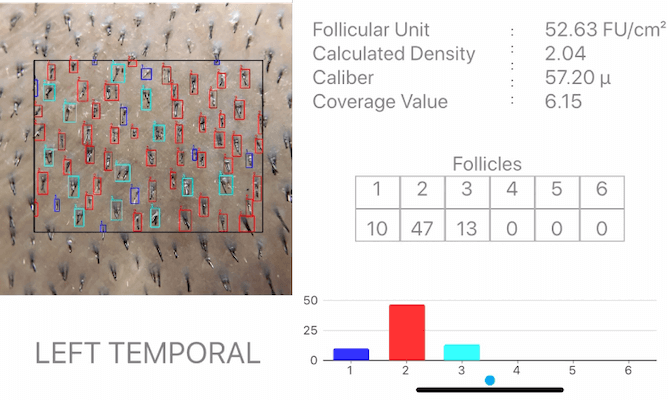
An average person has 120-200 hairs per square cm2; generally, 1 root has more than a single hair. Therefore, there is no direct relationship between graft count and hair density.
Then, the patient is informed about their scalp condition, hair quality and density, and donor/recipient areas. As a result of this step, the patient is advised of:
- The unique hair density and quality,
- The proper integrated treatment,
- Expected results and operational forecast.
Afterward, I will draw the hairline using a laser-assisted hairline device to set the perfect symmetry between the left and right sides.
Your wishes and our surgical team’s artistic abilities will define the desired hairline, considering:
- Forehead muscles,
- Face and bone structure,
- Ethnicity,
- Age,
- Balding severity,
- And donor capacity.
When the patient approves the hairline, the team moves on to the next step.
From then on, we enter the surgery phase:
💊 Our holistic approach towards transplant surgeries includes advanced technologies and bio-enhancements to ensure you do not need another surgery.
Once you have decided on which transplant method, along with our consultation, we begin the treatment with the utmost attention. 💉
But most importantly, we stay in contact with our patients even long after the surgery, ensuring that your transplant becomes permanent. 🍀
Affordable hair transplant costs, a holistic approach, and experienced dermatologists on-site are here to provide you with the right solution.
Ready to begin the journey? Click here to start the first step with a free consultation:
Maximize the potential of your donor area capacity.
Restore your natural look with a Dermatosurgeon.
Frequently Asked Questions (FAQs)
How to improve hair donor area?
You can include three habits in your daily life to improve your donor area. You can maintain a healthier diet. The most effective one we advise our patients is the Mediterranean diet. Its ingredients of primarily high protein, raw vegetables, and fresh herbs highly contribute to its effectiveness in reducing the risk of hair loss. You should try to consume raw vegetables and fresh herbs at least three times a week to see the results of this diet. Secondly, maintain a high blood circulation in your scalp. Movement and stimulation with exercise increase the amount of blood circulation in your scalp, which turns into more oxygen and nutrition flow going to your hair follicles. Alternatively, you can also apply scalp massages to stimulate the blood circulation in your scalp. Lastly, maintain a stress-free life. High amounts of continuous pressure from non-released stress increase hair loss. So, you should allow your body to release tension by applying options such as exercise.
How do you treat the donor area after a hair transplant?
After the bandages are removed, you will experience some itching and discomfort around the donor area. So, you should avoid following your instincts on touching the donor area. Until the first wash that should be done a day after your surgery with your physician, don’t let water get anywhere near your scalp. If necessary, you can carefully wash your body with slow movements (to avoid accidents), but you can’t wash your head for at least 24 hours. Aside from the regular washing you will have to do with the medical shampoo that your doctor gave, avoid any type of physical interaction with your scalp in the first month. And when you have to wash, only use warm water with little pressure (we even advise patients to use water sprays for the first weeks) to wash your hair. This is the most optimal choice for the well-being of your scalp. For a more detailed guide until a year after the surgery, check out our in-depth post-transplant recovery article.
When can I shave my donor area after a hair transplant?
You can shave and trim your donor area or have a haircut only after at least a month has passed since the surgery. In the first month, you should give your new hair a chance to go through the initial recovery and be safe from physical contact.

